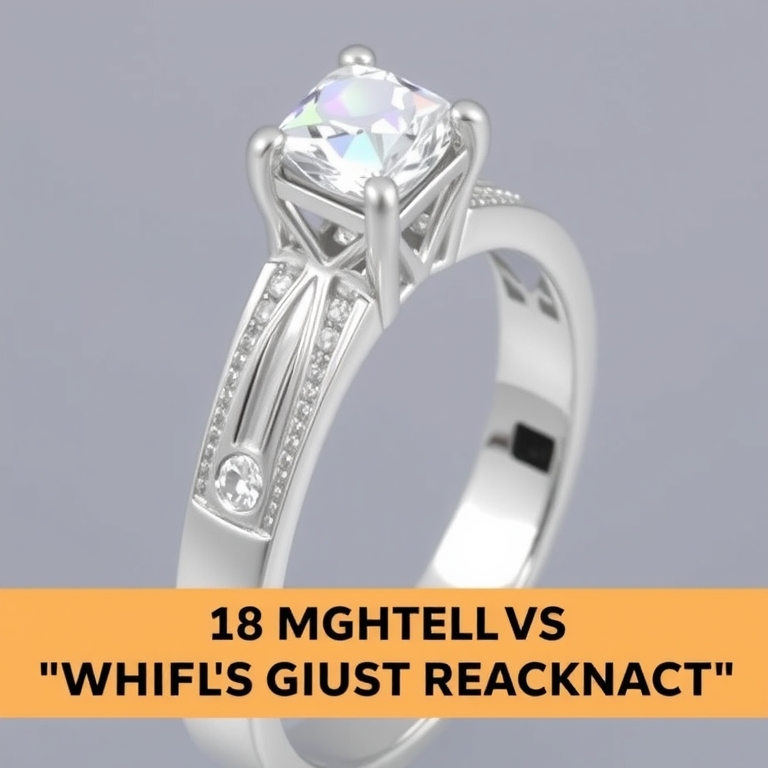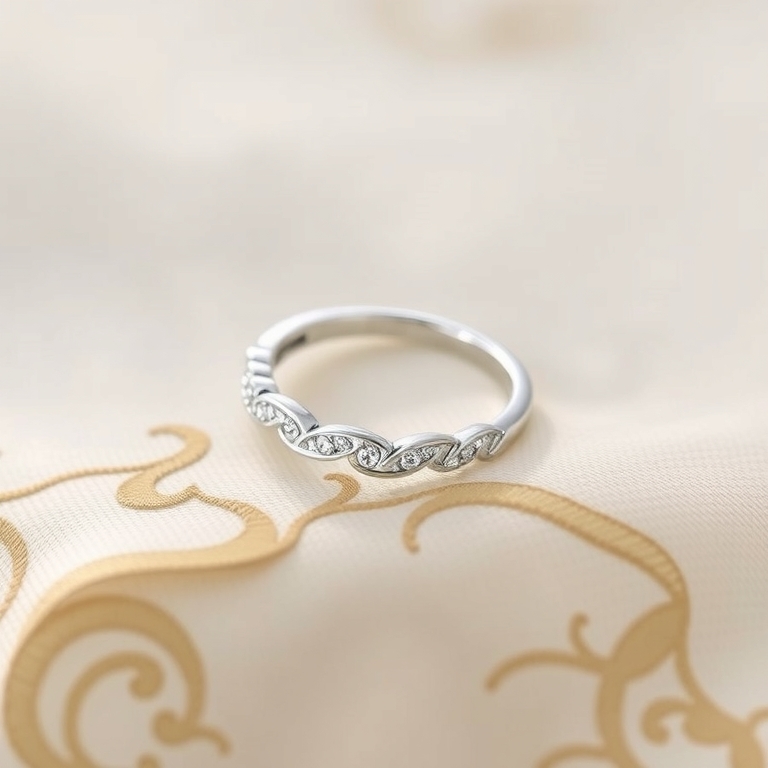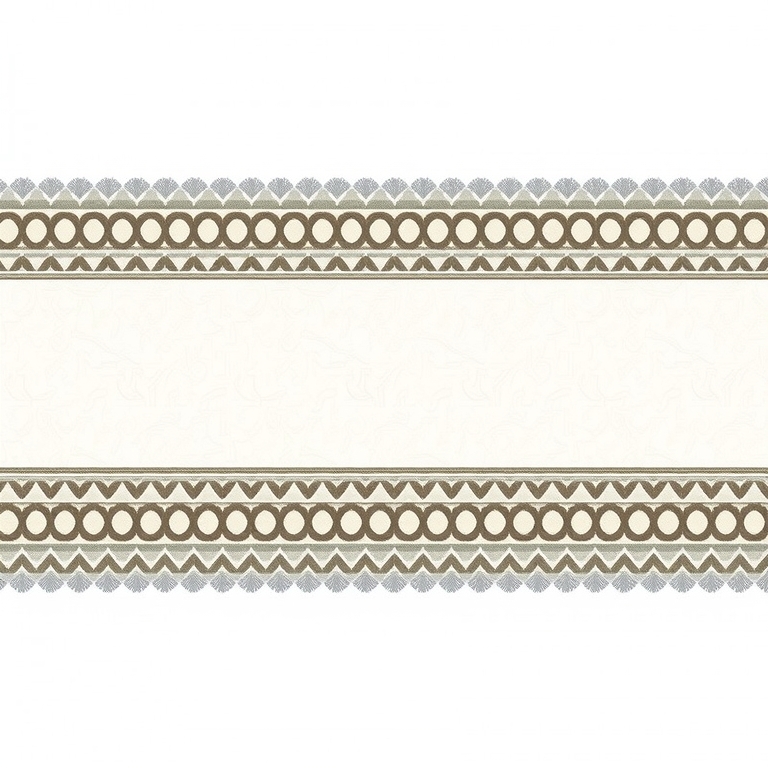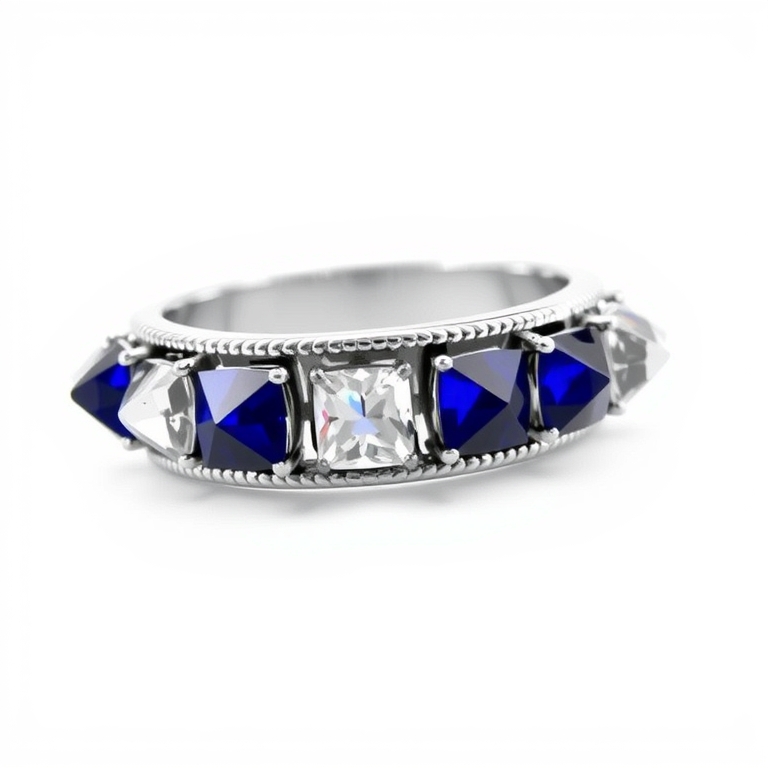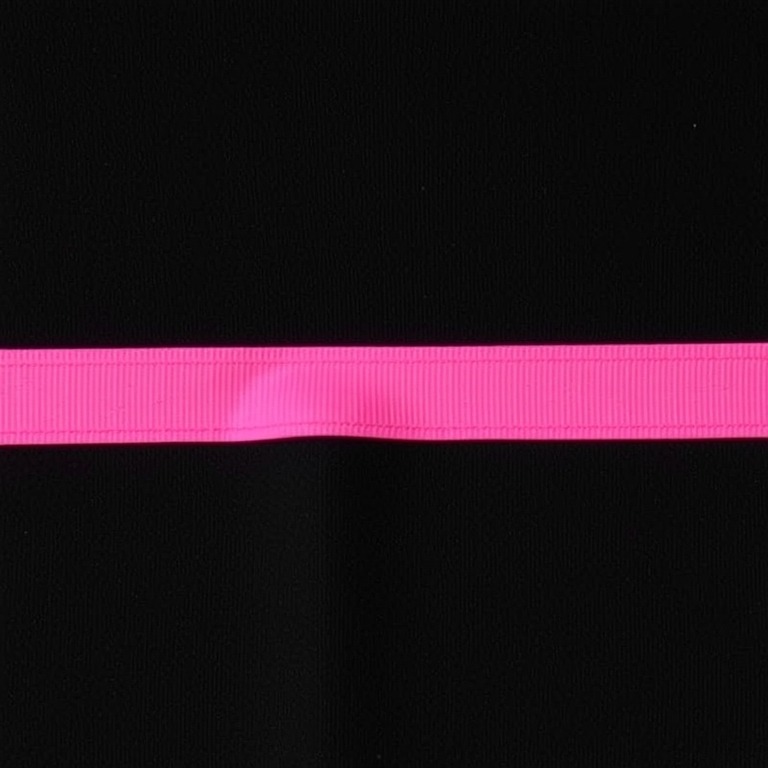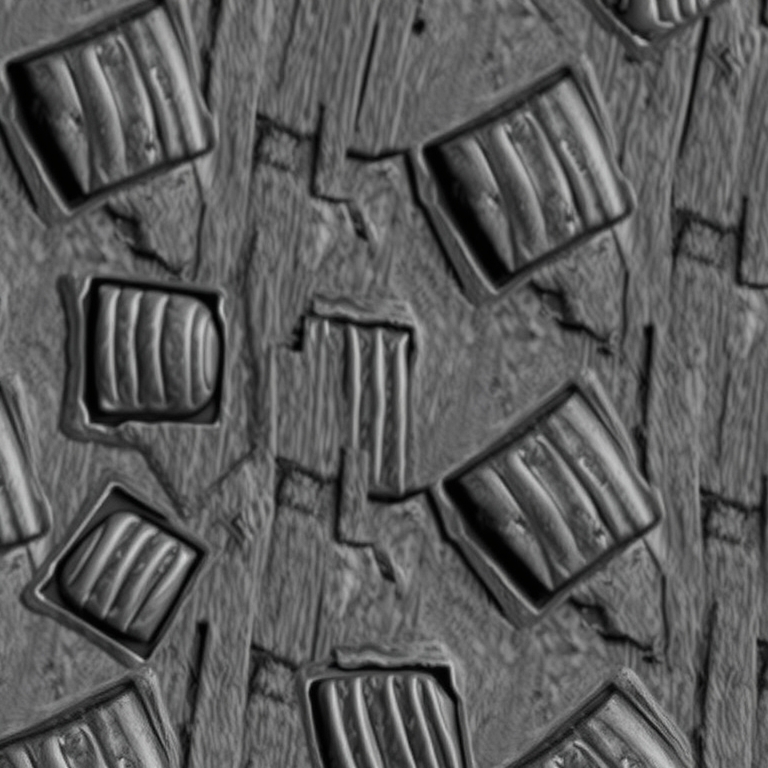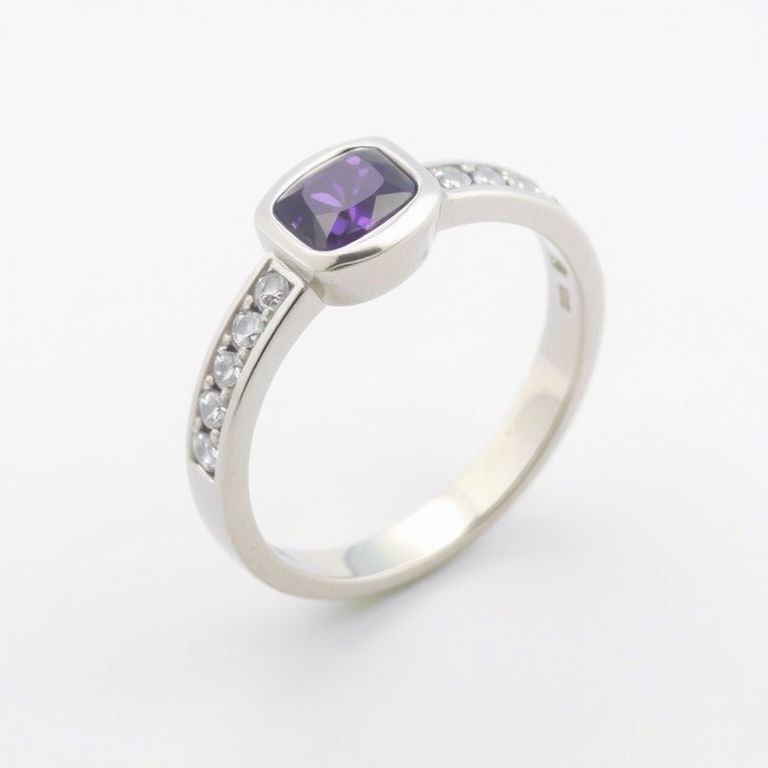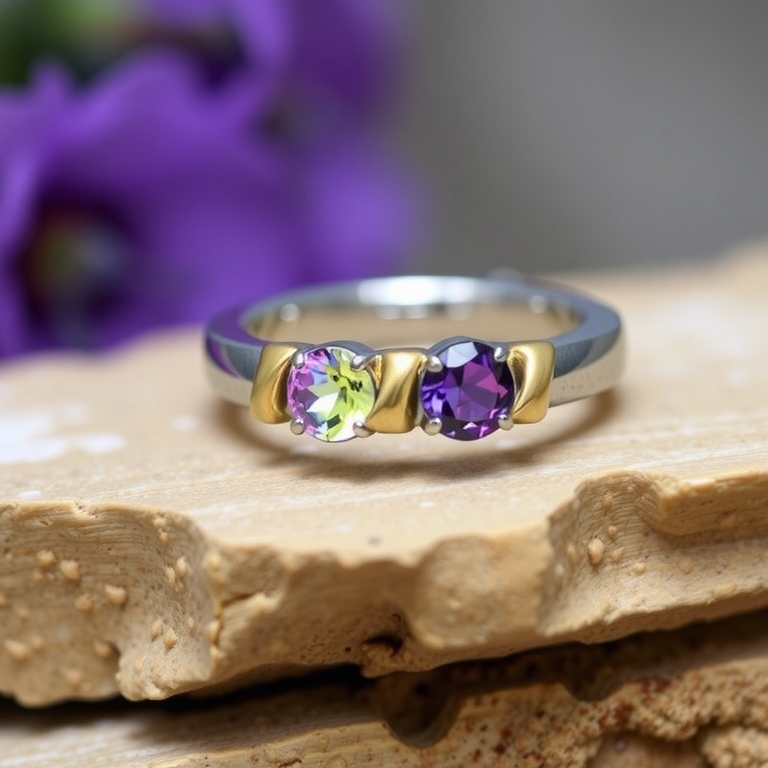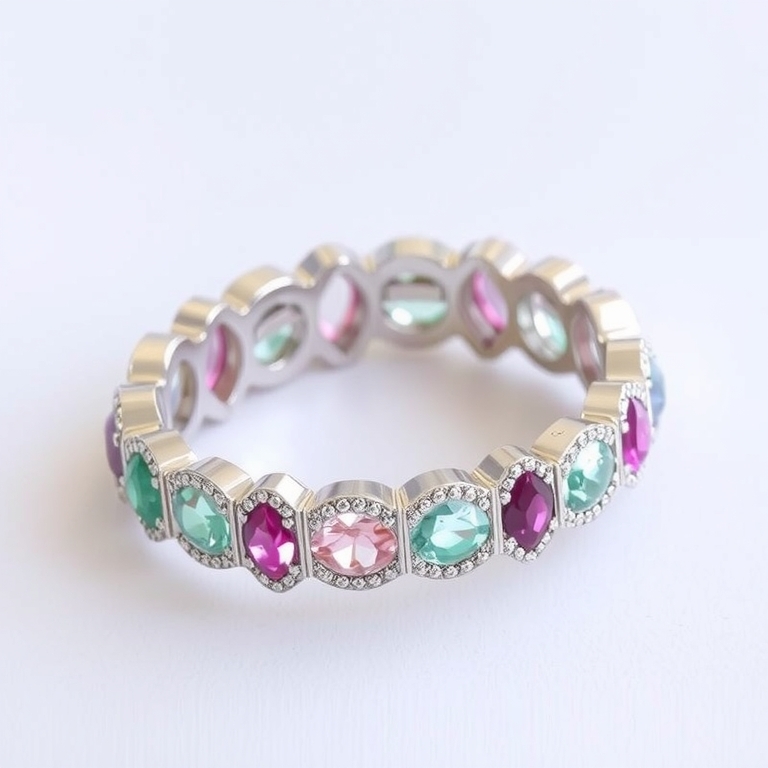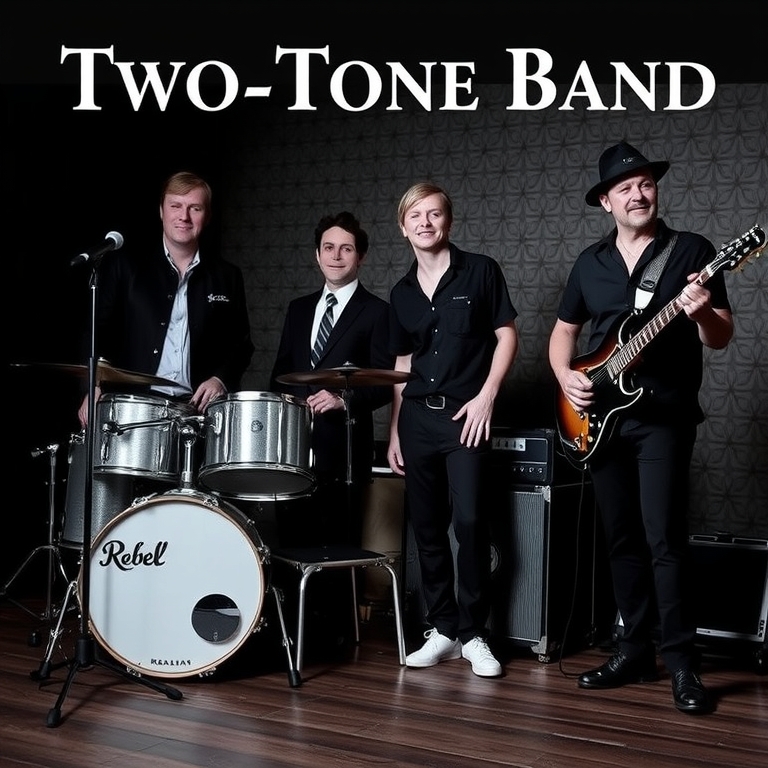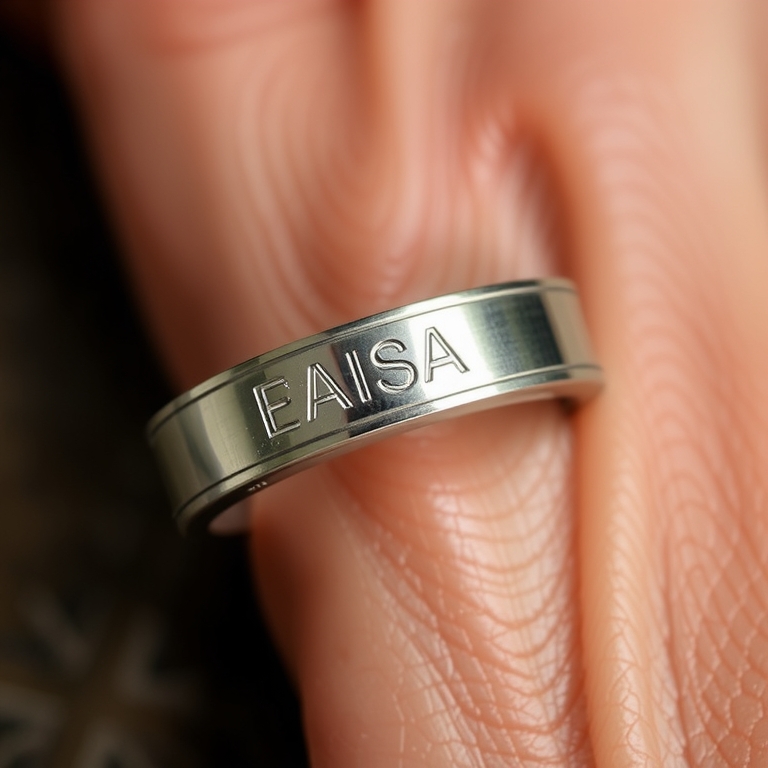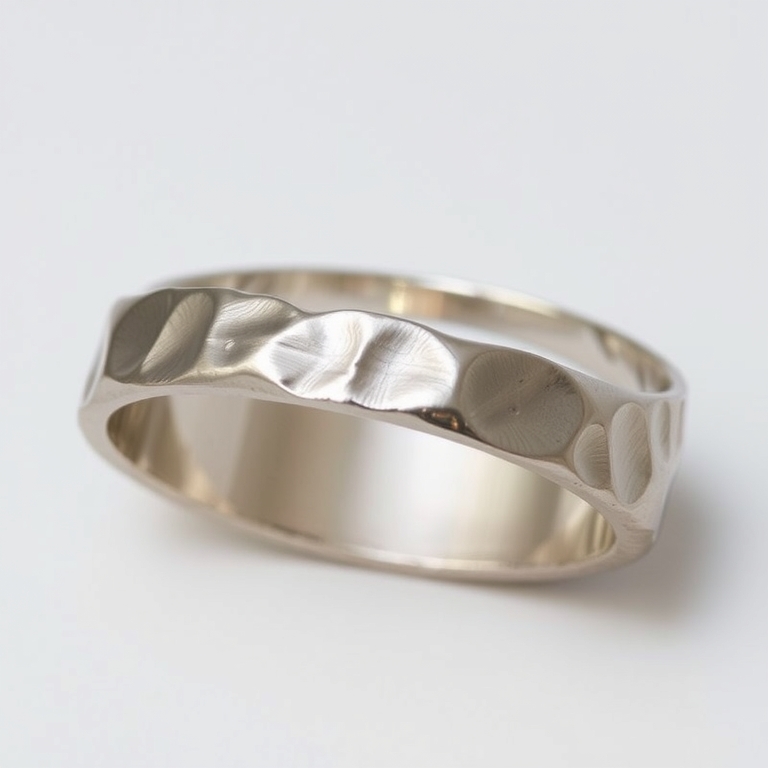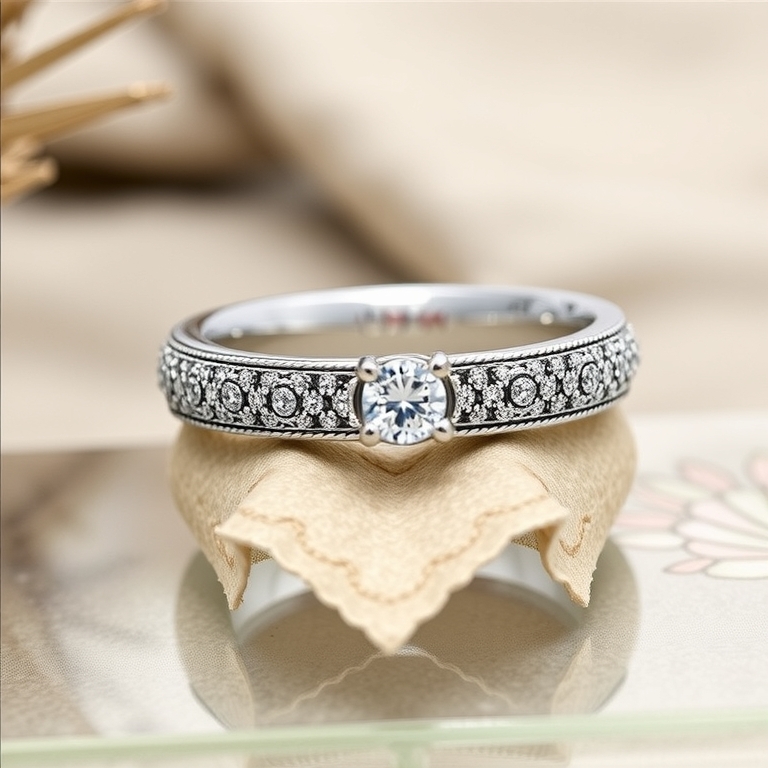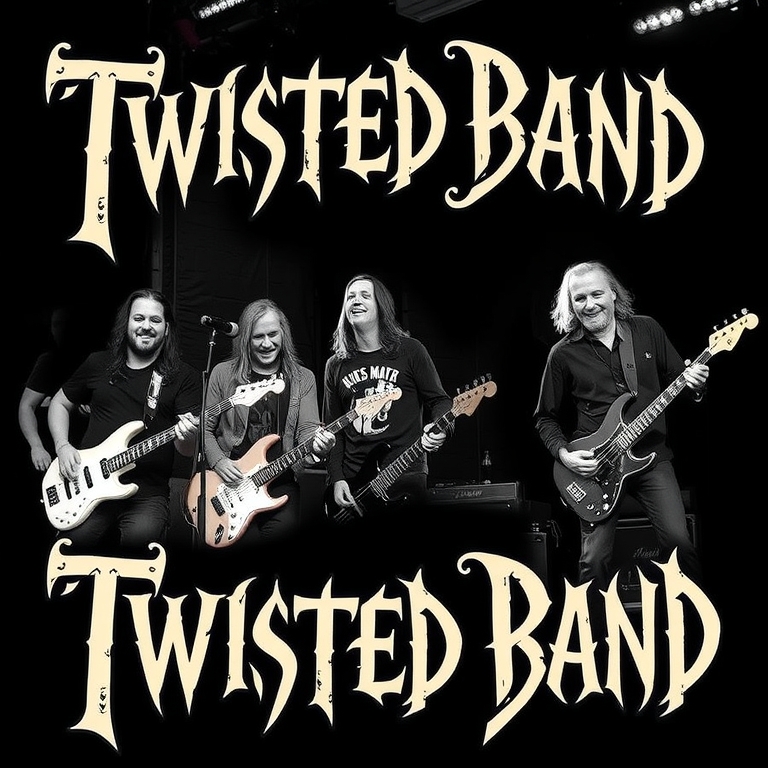Choosing the right ring band width to complement your wedding ring can feel overwhelming. But don’t worry! Finding the perfect match is all about understanding proportions and personal style. This guide will help you navigate the options and discover the ideal width for your unique taste.
We’ve compiled 18 stunning ideas, each explained in detail with practical tips and variations. Whether you prefer a classic, modern, or unique style, you’ll find inspiration to enhance your wedding ring’s beauty.
Remember to consider your lifestyle, hand size, and the overall aesthetic you’re aiming for. Let’s dive into the world of ring band widths and find your perfect match!
-
Classic Delicate Band

Classic Delicate Band A classic delicate band, typically 1-2mm wide, offers understated elegance and complements most wedding ring styles. Its slim profile allows for comfortable stacking with other rings. Consider a simple, polished finish for a timeless look or opt for a slightly textured surface for added interest.
For a slightly bolder yet still delicate option, try a band width between 2-3mm. This width provides a more noticeable presence without overwhelming the hand. A milgrain edge or subtle detailing adds a touch of sophistication. You can also experiment with different metals, such as rose gold or platinum, to match or contrast your wedding ring.
If your wedding ring is wider, a thinner band (1-2mm) will create a beautiful contrast and prevent an overly bulky look. Conversely, a wider wedding band may benefit from a slightly wider accompanying band (2-3mm) for balance. Consider the overall style of your wedding ring—a simpler band will pair well with an ornate wedding band, and vice versa.
Ultimately, the best width depends on your personal preference and the style of your wedding ring. Try on different widths to see what feels most comfortable and aesthetically pleasing. Don’t hesitate to experiment with metal types and finishes to achieve your ideal look. Consider your lifestyle; if you’re active, a slightly wider band might be more durable.
-
Modern Medium Width Band

Modern Medium Width Band A modern medium width band, typically 3-4mm wide, offers a versatile and stylish option for complementing wedding rings. This width is flattering on most hand sizes and styles, avoiding the bulkiness of wider bands while maintaining a noticeable presence. Consider a slightly domed profile for a comfortable and elegant look.
For a subtle contrast, choose a metal with a different finish than your wedding ring. A brushed platinum band paired with a polished white gold wedding ring provides visual interest without being overwhelming. Alternatively, a textured surface adds personality and visual complexity.
If your wedding ring is a classic solitaire, a simple medium width band provides a clean and elegant complement. For more intricate wedding rings, consider a slightly narrower band to avoid visual competition. A matching metal is usually a safe choice for a cohesive look.
Variations include adding small, subtle accents such as milgrain edging or a thin line of contrasting metal for a personalized touch. Consider incorporating your birthstone or a meaningful inscription for extra sentimental value. Remember that the overall goal is harmonious balance, not an exact match.
-
Bold Statement Band

Bold Statement Band A bold statement band makes a strong visual impact, perfect for those who want their wedding band to be a focal point. Consider a wider band, perhaps 6mm or more, in a striking metal like yellow gold or platinum. This works particularly well with simpler wedding bands, allowing the statement band to shine.
For a modern twist, opt for a bold band with unique textures or detailing. Hammered finishes, brushed metals, or even inlaid gemstones can add depth and visual interest. A wider band provides ample surface area to showcase these elements.
If a solid bold band feels too overwhelming, consider a half-round or comfort-fit profile for a more ergonomic and less bulky feel. This subtle change in shape can make a significant difference in comfort while still maintaining the bold aesthetic. Play with different metal colors for contrast.
Remember to consider the overall style of your wedding ring when selecting a bold statement band. A simple solitaire diamond ring pairs beautifully with a textured wide band, whereas a more ornate ring might need a simpler, wider band to avoid visual clutter. Balance and harmony are key!
-
Matching Width Band

Matching Width Band For a classic and cohesive look, choose a wedding band and engagement ring with matching widths. This creates a balanced and harmonious appearance on the finger. Consider a simple, straight band for a timeless style, or opt for a slightly curved band for a more modern feel.
If your engagement ring has a relatively thin band, a similarly thin wedding band will maintain a delicate and feminine aesthetic. Conversely, a wider engagement ring looks best paired with a proportionately wider band; this prevents the wedding band from appearing lost or overshadowed. Experiment with different metal finishes (polished, brushed, or matte) to add personality without disrupting the width match.
Slight variations in width can create visual interest while maintaining balance. For instance, if your engagement ring has a 2mm band, a wedding band that’s 2.5mm or 1.75mm could work depending on the overall design and your personal preference. Ensure the difference isn’t too drastic to avoid a jarring contrast.
Remember to try on different combinations with your engagement ring to see how the width proportions look together in person. Take your time and don’t hesitate to ask for professional advice from a jeweler. Ultimately, the perfect match should complement your engagement ring and reflect your personal style.
-
Slightly Thinner Band

Slightly Thinner Band A slightly thinner wedding band offers a delicate contrast to a thicker engagement ring, creating a visually appealing balance. Consider a band width of 1.5mm to 2mm for a subtle difference. This option works well with solitaire engagement rings or those featuring a central stone with smaller accent stones.
For a more defined contrast, pair a wider engagement ring with a band that’s noticeably thinner – perhaps 1mm to 1.5mm. The thinner band will elegantly complement the statement piece without overwhelming it. This is a particularly good choice if your engagement ring has a bold design or larger gemstones.
If your engagement ring has a medium width, a band just slightly thinner – perhaps 0.5mm to 1mm less – can create a cohesive and harmonious look. Pay close attention to the overall profile and metal type for a seamless transition between the rings. Matching metal tones (like platinum to platinum) will enhance the unity.
Experiment with different textures and finishes to add personality. A hammered finish on a thinner band can contrast beautifully with a polished engagement ring, or consider a matte finish for a more modern look. Remember to consider your personal style and the overall aesthetic you want to achieve.
-
Slightly Wider Band

Slightly Wider Band A slightly wider band, perhaps 2-3 millimeters more than your wedding ring, creates a beautiful and balanced contrast. This subtle difference adds visual interest without overpowering the existing ring. Consider a similar metal for a cohesive look, or a contrasting metal for a more striking effect.
If your wedding band is a delicate 1.5mm, a 3-4mm band will make a lovely pairing. For a wider wedding band, say 4-5mm, aim for a 6-7mm band to maintain proportion. Play with textures for added dimension; a hammered finish on the wider band next to a polished wedding band looks fantastic.
Think about the overall style of your rings; a simple, sleek wedding band might pair well with a slightly wider band with a subtle pattern. Conversely, an ornate wedding ring might look better with a simpler, wider band to avoid visual clutter. Don’t be afraid to experiment with different profiles; a flat band alongside a rounded wedding ring, or vice versa, can be very elegant.
Ultimately, the best width depends on personal preference and the specific rings involved. Visit a jeweler to try on various widths to see what feels and looks best on your finger and with your wedding band. Consider your lifestyle and daily activities when choosing your band width; too wide, and it might get in the way.
-
Textured Band

Textured Band A textured band offers a unique and visually interesting alternative to a plain wedding band. Consider subtle textures like hammered or brushed finishes for a delicate look, or opt for more pronounced textures like rope or woven patterns for a bolder statement. The texture can add depth and dimension to the ring, making it stand out beautifully alongside your wedding ring.
Matching the metal is key when choosing a textured band. If your wedding ring is yellow gold, choose a yellow gold textured band. If your wedding ring has a mixed metal design, a textured band in one of those metals can complement it beautifully. Alternatively, a similar texture in a contrasting metal can create an intriguing effect.
The width of the textured band should complement the width of your wedding ring. A wider wedding ring pairs well with a wider textured band, while a thinner ring might look better with a narrower band. Experiment with different widths to see what looks best. Consider the overall style – a delicate textured band might suit an understated look, while a bolder design may enhance a more dramatic aesthetic.
Don’t be afraid to experiment with different textures and finishes. You can achieve different looks by combining multiple textures or by varying the intensity of a single texture. For example, you might have a brushed finish on the outside and a polished finish on the inside. This will add an extra element of personality and visual appeal to your ring.
-
Bezel-Set Gemstone Band

Bezel-Set Gemstone Band A bezel-set gemstone band offers a sleek and modern look, perfectly complementing a variety of wedding ring styles. The continuous metal surrounding the gemstone creates a protective barrier, ideal for everyday wear. Consider a thin band for a delicate touch or a slightly wider band for a bolder statement. Matching the metal color to your wedding ring ensures a cohesive and harmonious aesthetic.
For a classic and elegant pairing, choose a bezel-set band with a gemstone that complements the center stone of your wedding ring. Diamonds, sapphires, and emeralds are all popular choices. Experiment with different gemstone cuts, such as round, princess, or oval, to find the perfect fit for your style. A pave setting alongside the bezel-set gemstone adds extra sparkle and visual interest.
If your wedding ring features a specific metal or pattern, consider mirroring that in your band for a unified look. For example, a milgrain-edged wedding ring pairs beautifully with a milgrain-edged bezel-set band. Alternatively, if your wedding ring is simple and understated, a bezel-set band with a unique gemstone offers a stylish contrast. The combination allows for a personal touch while maintaining harmony.
Remember to consider the overall proportions. A thin wedding ring might look overwhelmed by a wide bezel-set band, while a chunky wedding ring might need a wider band to maintain balance. A professional jeweler can offer personalized advice to ensure the perfect proportions and harmonious combination. Try on various options to see which band best complements your wedding ring and personal style.
-
Channel-Set Gemstone Band

Channel-Set Gemstone Band A channel-set gemstone band offers a sleek, modern look that complements many wedding ring styles. The continuous line of gemstones creates a dazzling effect, and the flush setting protects the stones from snagging. Consider using smaller gemstones for a more delicate appearance, or larger stones for a bolder statement.
Matching the metal color of your wedding ring is key for a cohesive look. A platinum or white gold channel-set band pairs beautifully with a similar wedding ring, while yellow or rose gold offers a warmer contrast. The gemstone color should complement, not compete with, the center stone of your engagement ring.
For a subtle variation, choose gemstones that echo the color of your wedding ring’s accent stones. If your wedding ring has small diamonds, consider a channel-set band with sapphires or other colored gemstones in a similar hue. Experiment with different gemstone shapes, like round, baguette, or princess cuts, to customize your look.
Alternatively, a minimalist approach is to use a single row of small diamonds or other gemstones in a shared prong setting. This option offers a refined elegance that coordinates well with solitaire or simple wedding bands. Remember to consider the overall width of your wedding ring when choosing the band width; aim for a band width that maintains visual balance and harmony with your existing jewelry.
-
Pavé-Set Gemstone Band

Pavé-Set Gemstone Band A pavé-set gemstone band offers a luxurious and eye-catching complement to a variety of wedding rings. The tiny gemstones create a continuous sparkle, enhancing the overall brilliance. Consider the metal color—white gold or platinum for a modern look, yellow gold for a classic feel—to match your wedding ring.
The size of the gemstones in the pavé setting is key. Smaller stones create a delicate and refined look, suitable for thinner wedding bands. Larger stones offer more dramatic impact, complementing bolder wedding ring styles. Match the gemstone type—diamonds, sapphires, or emeralds—to your wedding ring’s stones or your personal preference.
For a unique twist, choose a mixed metal pavé band. A combination of rose and yellow gold, or white gold and platinum, adds visual interest. You could also incorporate different gemstone colors for a more eclectic aesthetic. Ensure the metal tones are harmonious with your wedding ring’s metal.
Remember to consider the overall width of the band relative to your wedding ring. A thicker band balances a wide wedding ring, whereas a narrower band pairs better with a thinner ring. Prioritize comfort—try on several widths to find the perfect fit and feel for your lifestyle.
-
Mixed Metal Band

Mixed Metal Band A mixed metal band offers a unique and stylish way to complement your wedding ring. Consider pairing a rose gold wedding band with a yellow gold or platinum mixed metal band for a contrasting yet harmonious look. This approach adds visual interest and subtly showcases different metal tones. The contrast can be quite striking and modern.
For a more subtle approach, choose bands with similar metal colors, but in different finishes. For instance, pair a matte rose gold wedding ring with a polished rose gold and white gold mixed metal band. This creates depth and texture without being overly flashy. You can experiment with different textures like brushed, hammered, or polished finishes.
Another popular option is combining metals that are adjacent on the color spectrum. A platinum wedding ring pairs well with a white gold and yellow gold mixed metal band. The slight variation in color creates a subtle yet sophisticated look. The gentle transition between metals softens the overall aesthetic, making it elegant and understated.
Remember to consider the overall style of your wedding ring when choosing a mixed metal band. A simple solitaire diamond ring might pair best with a delicate mixed metal band, while a bolder, more ornate ring might benefit from a more substantial mixed metal design. The width of the mixed metal band should also be proportionate to the width of your wedding ring, ensuring a balanced and harmonious look.
-
Two-Tone Band

Two-Tone Band A two-tone wedding band offers a stylish and modern approach to complementing your existing ring. Consider contrasting metals like yellow gold and white gold or rose gold and platinum for a visually striking effect. This option works well if your wedding ring is a single metal; the two-tone band adds depth and complexity.
For a subtle variation, choose a two-tone band where one metal is dominant. Perhaps a wide band of yellow gold with a thin stripe of white gold inlaid. Alternatively, a rose gold band with platinum accents provides an elegant, understated look. This allows you to incorporate the two-tone element without overwhelming your existing ring.
The width of your two-tone band should ideally be proportionate to your wedding ring. If you have a thin band, a slightly wider two-tone band can create a nice balance. Conversely, a thicker wedding ring might pair well with a band of similar or slightly less width. Experiment with different widths to find the perfect fit.
Remember to consider the overall style of your wedding ring when selecting a two-tone band. A classic solitaire diamond ring might look stunning with a delicate two-tone band, whereas a more ornate ring might suit a bolder, wider design. Seek professional advice from a jeweler to ensure the two pieces complement each other harmoniously.
-
Etched Band

Etched Band An etched band offers a unique and subtle way to complement your wedding ring without overpowering it. Consider a delicate, linear etching for a minimalist look, or a more intricate pattern for added visual interest. The depth and width of the etching can be customized to match the style of your wedding band.
For a wedding ring with a wider band, a slightly wider etched band can create a balanced and harmonious appearance. Conversely, a thinner wedding ring might pair well with a narrower etched band, maintaining visual proportion. Experiment with different etching styles – geometric patterns, floral motifs, or even personalized initials – to find the perfect match.
Matching metal is key for a seamless and cohesive look. If your wedding ring is platinum, choose a platinum etched band. Similarly, a yellow gold wedding ring pairs beautifully with a yellow gold etched band. The consistent metal will ensure a visually pleasing harmony.
To add a touch of personality, consider incorporating a contrasting metal inlay into the etching. A thin line of rose gold within a yellow gold band, for example, creates a subtle yet striking detail. Remember that the focus should be on complementing, not competing with, your wedding ring.
-
Hammered Band

Hammered Band A hammered band offers a unique texture that complements many wedding ring styles. Its subtle irregularities add visual interest without being overly flashy. Consider a slightly wider band, around 4-6mm, for a bolder statement that still pairs well with a thinner wedding band.
For a more delicate look, opt for a narrower hammered band, approximately 2-3mm wide. This works particularly well if your wedding band is also slim or features intricate details. The hammered texture provides a pleasing contrast without overwhelming the overall design.
The metal choice significantly impacts the hammered band’s appearance. A platinum or white gold hammered band looks sophisticated and modern. Yellow gold or rose gold offer warmer, more romantic vibes. Experiment with different metals to find the perfect match for your skin tone and wedding ring.
Varying the width of the hammering itself can create subtle changes in the overall effect. A band with deeply hammered textures appears more dramatic, while a finely hammered band is more understated. This level of customization allows you to tailor your ring to your exact preferences.
-
Milgrain Band

Milgrain Band A milgrain band, with its delicate beaded edge, offers a timeless and versatile option for pairing with wedding rings. Its intricate detail complements both simple and ornate wedding bands, adding a touch of elegance without overwhelming the overall look. Consider a thinner milgrain band for a more subtle accent or a wider band for a bolder statement.
For a classic look, choose a milgrain band in yellow gold to match a traditional yellow gold wedding ring. Alternatively, a platinum or white gold milgrain band pairs beautifully with a platinum or white gold wedding ring, creating a cohesive and sophisticated ensemble. Rose gold milgrain bands add a romantic touch and work well with rose gold or even yellow gold wedding bands.
Playing with the metal’s finish can also enhance the milgrain’s visual appeal. A matte finish on the band offers a modern twist, while a high-polish finish provides a more traditional, glamorous look. Experiment with different textures to find the perfect complement to your wedding ring’s finish.
The width of the milgrain band should be considered relative to the wedding band’s width. A significantly wider milgrain band can visually balance a thin wedding ring, while a thinner milgrain band will complement a wider wedding ring. A good rule of thumb is to choose a milgrain band width that is either similar to or slightly thinner than your wedding band.
-
Plain Band

Plain Band A classic plain band offers timeless elegance and versatility, making it a perfect complement to almost any wedding ring style. Consider the metal: platinum for durability, yellow gold for warmth, or rose gold for a romantic touch. Its simplicity allows your wedding ring to take center stage, creating a harmonious yet understated look. Choose a width that complements your wedding band – a similar width for a unified look or a slightly thinner band for a more delicate feel.
For a subtle variation on the classic plain band, consider adding a subtle texture. A lightly hammered finish adds depth and visual interest without overpowering the design. A brushed finish provides a more matte, modern look. Even a very fine milgrain edge can add a touch of sophistication without detracting from the overall simplicity. These small details can elevate a simple band and personalize its appearance.
Matching the metal is key for seamless integration. If your wedding ring is platinum, a platinum plain band is a natural choice. If your wedding ring has a mixed metal design, consider using the dominant metal for your plain band for the best visual harmony. The width should also complement the width of the wedding band, creating balance and visual appeal. A simple rule of thumb is to choose a band width slightly thinner or the same width as the wedding band.
Ultimately, the best width for your plain band depends on your personal preferences and the style of your wedding ring. Experiment with different widths in the store and see what feels most comfortable and visually appealing. Consider your overall style and the overall look you are trying to achieve. Don’t hesitate to ask for advice from a jeweler on the best width for your specific wedding ring and personal taste.
-
Twisted Band

Twisted Band A twisted band offers a unique and stylish alternative to a traditional wedding band. Its intertwining design adds texture and visual interest, complementing both simple and ornate engagement rings. Consider a thin twisted band for a delicate look or a thicker one for a bolder statement.
The metal choice significantly impacts the overall aesthetic. A twisted band in platinum or white gold pairs beautifully with a diamond engagement ring, offering a sleek and modern feel. Yellow gold or rose gold twisted bands provide warmth and a more romantic vibe, complementing gemstone or vintage-style rings.
Variations on the twisted design are abundant. You can choose a band with a single twist or multiple twists for a more complex pattern. Incorporating different metals into the twist, such as combining yellow and white gold, can add an extra layer of visual appeal.
When selecting a twisted band, ensure it’s comfortable to wear and proportionate to your engagement ring. The width of the twisted band should complement the ring’s size without overwhelming it or appearing too dainty. Experiment with different widths and metal combinations before making your final decision.
-
Rope Band

Rope Band Rope bands offer a unique texture and visual interest, complementing many wedding ring styles. Their twisted design adds a touch of subtle detail without overpowering the main ring. Consider a thinner rope band for a delicate look, or a thicker one for a bolder statement. Matching metal is key for seamless integration.
A classic choice is a simple, evenly twisted rope band in the same metal as your wedding ring. For a modern twist, explore rope bands with a slightly hammered or brushed finish; this adds depth and visual complexity. You can also play with different metal colors – for example, a rose gold rope band with a yellow gold wedding ring.
If your wedding ring features gemstones, choose a rope band without embellishments to let the stones take center stage. Alternatively, a subtly textured rope band adds a touch of visual harmony without competing with the gemstones. Pay attention to the width of your wedding ring – a proportionally sized rope band will maintain balance and avoid looking disproportionate.
Ultimately, the best rope band width depends on your personal preference and the overall style of your wedding ring. Experiment with different widths and finishes in person to find the perfect complement. Don’t hesitate to consult with a jeweler for guidance; they can offer expert advice based on your specific ring and style preferences.
Editor’s Recommendations
- Consider your wedding ring's style and metal when choosing a band width.
- Try on different widths to see what feels most comfortable and aesthetically pleasing.
- Don't be afraid to experiment with different textures, metals, and gemstones.
Conclusion
Selecting the perfect ring band width to complement your wedding ring is a journey of personal style and careful consideration. We hope this guide has inspired you and empowered you to make an informed choice.
Remember to consider the overall aesthetic, your lifestyle, and your hand size. Don’t hesitate to try on different widths to see what feels and looks best on you.
Ultimately, the best ring band width is the one that makes you feel confident and beautiful. Choose a style that reflects your unique personality and enhances your wedding ring’s beauty.

